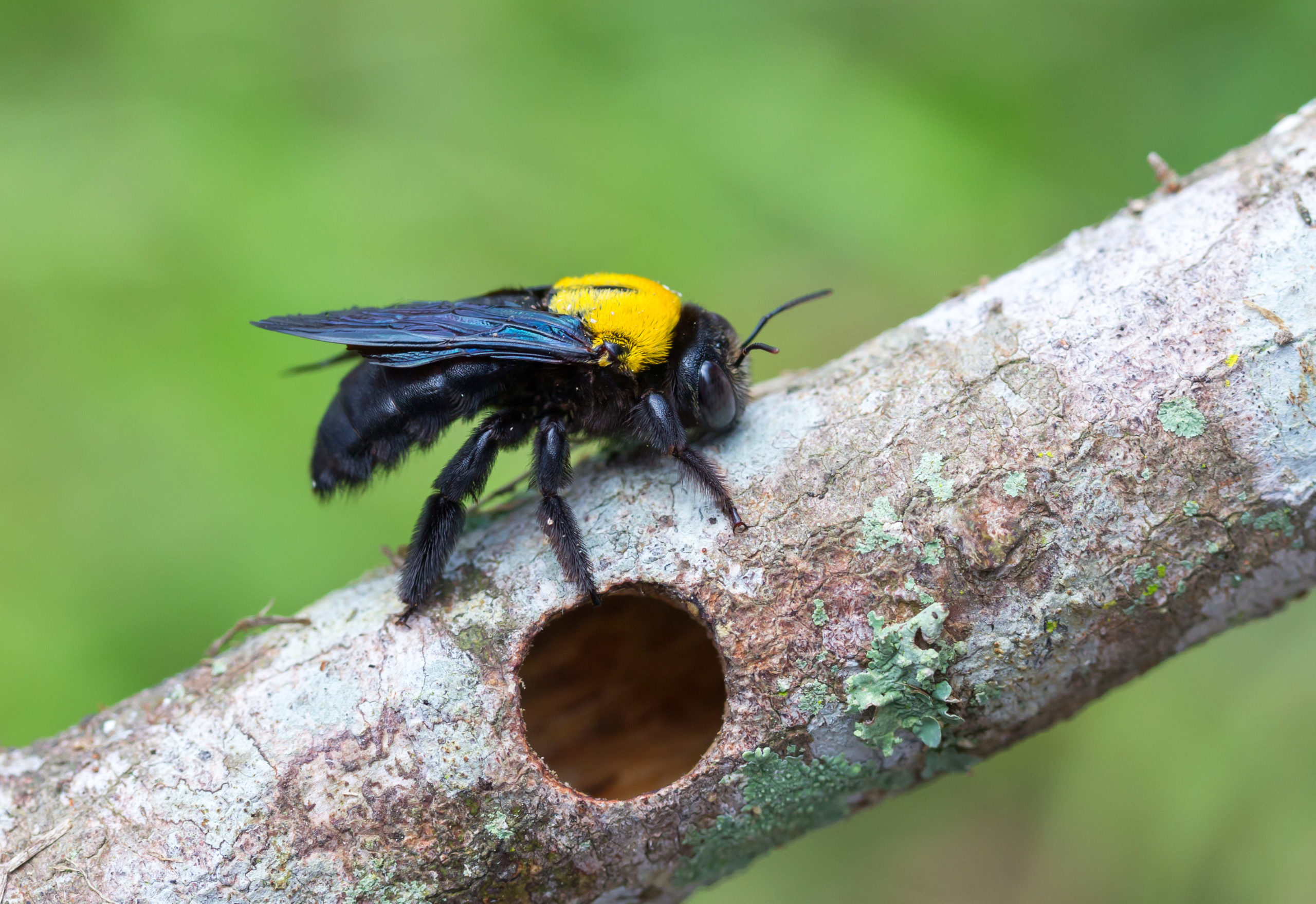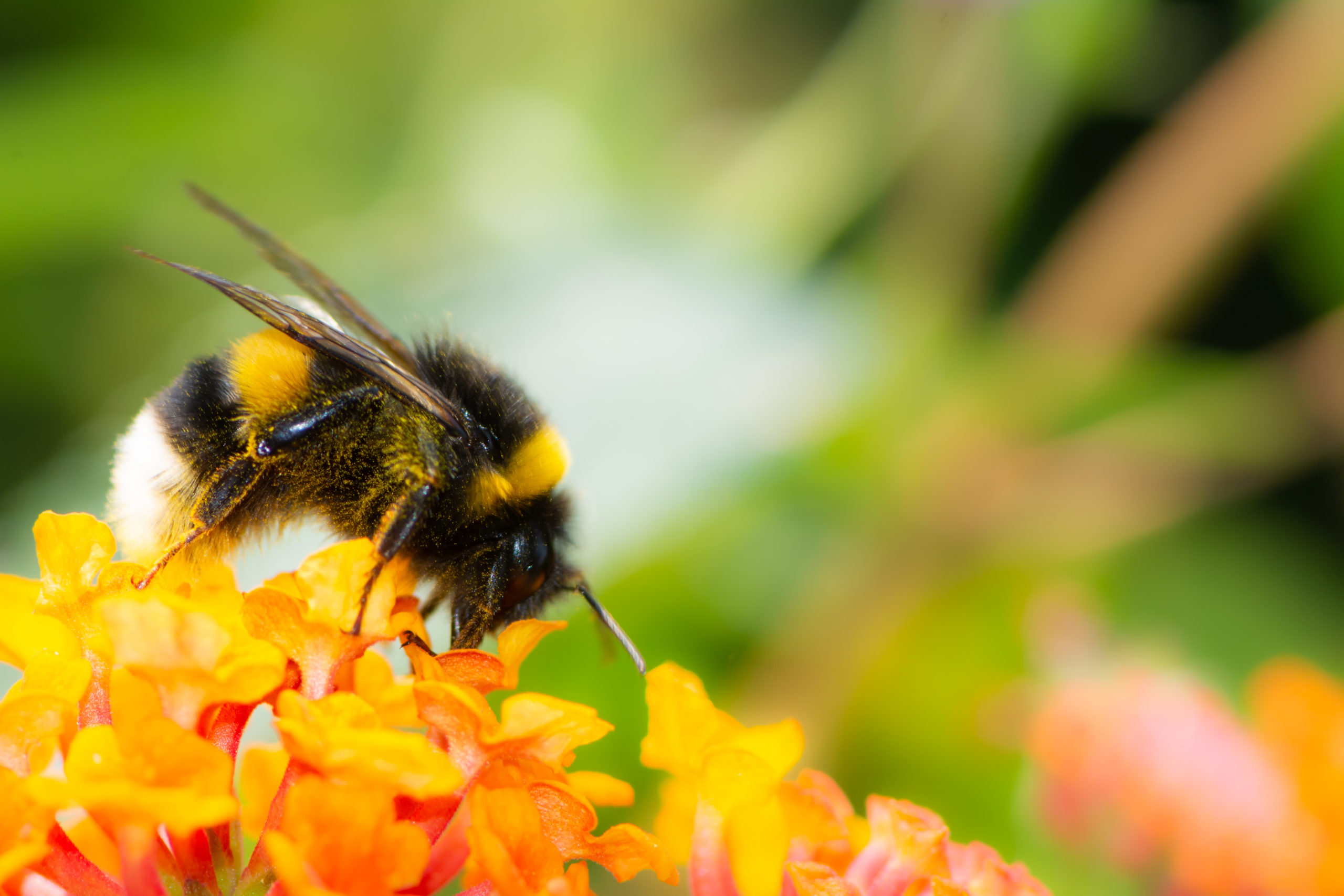Carpenter Bees: Scary Gentle Giants
Carpenter Bees: Scary Gentle Giants
Our fear of certain insects is usually due to two factors: size and danger. The larger the insect or the sharper their defense mechanisms are, the more panic they elicit in us when they get too close for comfort. One such insect is the carpenter bee. They are the huge black bees that look terrifying, but are actually gentle giants. They are abundant in the spring, often found loudly buzzing near flowers and gardens. But many people don’t know what carpenter bees actually do or eat, since all we typically focus on is the alarming size of these pollinators.
What’s in a Name?
Carpenter bees are similar to carpenter ants in that they also bore into wood for their nests. Carpenter bees gnaw round holes in wood with their strong jaws, or mandibles. They prefer dead, not decaying, wood. This means that they are not harming anything with their nesting unless they turn to live wood for their homes. While carpenter bees do damage wood by boring into it to make their nests, this is not their primary objective. They primarily use wood for nesting because it is a sturdy building material that can withstand the weathering process.
Their housing is also practical and secure for their eggs once they are laid. The mother carpenter bee builds the nest by gnawing into the wood and carving out tunnels with her mandibles. She will then make “loaves” made out of pollen or nectar to actually lay the eggs on. Once an egg is laid on a loaf, the mother will craft dividers between cells of the nest using her salvia and the sawdust from gnawing through wood. The mother and father will also leave nectar for each cell so that every egg has food when it hatches. Sadly, the mother and father will die in the nest before the eggs hatch, so they are on their own from day one. But the life of a carpenter bee is an active one, so they have plenty of activities to fill their days.
The Life and Times of the Carpenter Bee
Since we usually only see the big carpenter bees when they find a flower particularly interesting, it’s fun to look into the life of these gentle giants. They are the largest native bees in the U.S. and can live in a wide range of climates, including tropical and temperate. Similar to other types of bees and common flying insects, carpenter bees are most active in early spring when their eggs begin to hatch. They live for up to three years, and can have multiple generations be born in one year. As mentioned earlier, carpenter bees don’t have queens or workers, since every nest consists of one family that the pollen is used to feed. Carpenter bees are mainly generalist herbivores, feeding on the nectar and pollen of flowers. They love all kinds of flowers and vegetables, and like to forage early in the morning.
Carpenter bees mainly pollinate by sonicating. It sounds like something to do with music, but that’s because it’s using sound energy. The carpenter bee vibrates particles in the flower’s anther to release the dry pollen within them. This process is also referred to as “buzz pollination” and explains why the bees seem to constantly be buzzing when they are around flowers. While their large size is helpful in gathering more pollen and nectar and warding off potential predators, it is also limiting in the variety of flowers they can get into. Flowers with tubular shapes are off-limits for carpenter bees because the bees’ bodies are too big to get to the best parts of the flower. That is, unless the bees get innovative and take another route. Many carpenter bees will steal the nectar of a flower by getting the nectar from the outside base and piercing a hole in the flower’s corolla. This is known as stealing the nectar because the bee isn’t pollinating the flower, so they aren’t helping the flower in return. Luckily, other types of bees can fit in the tubular structures, so they can keep the flower healthy by pollinating it.
Carpenter bees are not aggressive and will not sting humans unless they are handled roughly. Males don’t even have stingers, so the only stings would come from female carpenter bees. Both males and females are territorial, which means they will loudly buzz around your head if you get too close to their nest. The female carpenter bee can sting more than once, but her reluctance to do so means you have more time to leave the area before she attacks. The best way to tell the difference between males and females is appearance. Males are golden-tinted and have green eyes, while females are almost completely black. As part of an interesting mating ritual, males will release floral-scented chemicals around other males on non-floral plants, and female carpenter bees choose the male they want to mate with. Thus continues the circle of life and more nest-building for these busy bees.
Pest vs. Beneficial Insect

A carpenter bee nest
The line between pest and beneficial insect blurs with many common insects, and carpenter bees are no exception. Bees are beneficial insects by nature, since their pollination of flowers keeps the beloved flora of our world alive and healthy. Some bees also manufacture honey, which we enjoy as a natural sweetener. Carpenter bees are beneficial for the same reason. They pollinate many types of crops while they are out gathering nectar and pollen. Their favorites include blueberries, melons, tomatoes, and eggplants. They can also pollinate while nectar robbing, even if it’s inadvertently since they can’t reach the center of the flower.
But carpenter bees can also become a pest if their population is too high in an area and if they don’t stick to their normal home of dead wood. When a carpenter bee tunnels into good wood, or wood that is being used as support for a house or garage, it is bad news for us. They may not deal the same amount of damage that carpenter ants would, since carpenter bees don’t live in a colony and rely on pollen and nectar for food. But it is still frustrating to find your fence full of small holes when it wasn’t that way last week. If they don’t pollinate the flower, carpenter bees’ habit of nectar-stealing is also the act of a pest. A garden of flowers can turn quickly if they are not adequately pollinated while their nectar supply is sucked dry.
So the status of a carpenter bee is inconclusive, as you can tell. As long as they don’t gnaw through good wood or kill flowers, they are beneficial insects and can be left alone to do their pollinating duties.
What’s the Difference Between a Bumble Bee and Carpenter Bee?

Carpenter Bee

Bumble Bee
If you have never seen a carpenter bee, you may be wondering if there are a lot of differences between them and the classic bumble bee. Both pollinate flowers and have stingers, so are there that many differences between the bees?
The answer is yes. Although they share the typical bee responsibilities and habits, both kinds have their own interesting lives. Bumble bees are essential pollinators since they are so good at it, while carpenter bees don’t make the largest difference in pollinating flowers. They certainly help, but they don’t work at it as quickly or fervently as bumble bees, so they aren’t considered to be strong pollinators. Bumble bees are also social insects with a queen and underground hive, while carpenter bees are solo and temporarily live with their family in a nest built by the female. Both bees are different in appearance, as you may already know. Bumble bees are the more visually-appealing of the two, with their fuzzy hairs and black and yellow coloring. They are also much smaller than carpenter bees. Carpenter bees are either all black or golden-tinted, depending on the gender, and are not fuzzy besides a small section on their body. The female may have some yellow coloring on her head, but is completely dark otherwise.
The easiest ways to distinguish between the two kinds of bees are to either look at their appearance or watch where they go to hide at home. Bumble bees will go underground, while carpenter bees will go into some kind of wood. Both bees are important to the ecosystem (in manageable quantities, of course), so it’s good to leave them alone if they are dutifully pollinating your garden or yard.
Pest Control Can Help with Any Bee Problem
Carpenter bees are not the most dangerous pests even when they bore into wood, but they can become a problem as multiple generations begin to hatch in one area. Pest control is needed to take care of these bees because their nests are so intricate and have layers that must be broken through with equipment. You can always call our pest control team to learn more about options for handling an infestation of large bees that make their homes in the wood of your house or yard. Our EPA-approved treatments will solve the infestation problem without harming the ecosystem or your yard, which means that the pollinators can continue their duties without becoming a danger to your family.
Citations
Big black bees? How to differentiate a bumble bee vs carpenter bee. (2019, March 1). Best Bee Brothers. Retrieved on April 4, 2022, from https://bestbeebrothers.com/blogs/blog/black-bees-how-to-differentiate-bumble-bee-vs-carpenter-bee
Buchman, S. (n.d.). Carpenter bees (Xylocopa spp.). U.S. Forest Service. Available at https://www.fs.fed.us/wildflowers/pollinators/pollinator-of-the-month/carpenter_bees.shtml (Accessed on April 4, 2022).
Garvey, K.K. (2017, January 3). Carpenter bee: Beneficial insect or pest? UC ANR: Bug Squad. Available at https://ucanr.edu/blogs/blogcore/postdetail.cfm?postnum=22898 (Accessed on April 4, 2022).
Things to know about carpenter bees. (2021, March 12). Perma-Chink Systems, Inc. Retrieved on April 4, 2022, from https://www.permachink.com/blog/carpenter-bees

